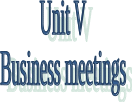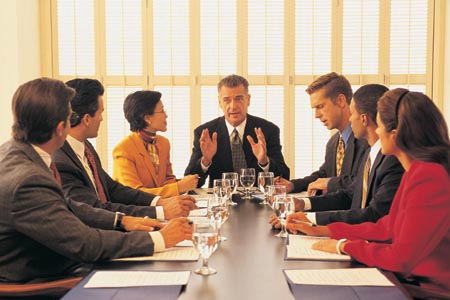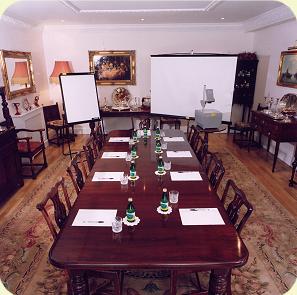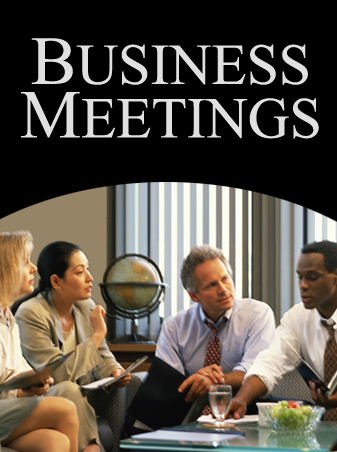
- •Improving Communications
- •Oral communications
- •Written communications
- •7 Tips to become a Good Conversationalist
- •Six Common Mistakes That Spoil Conversations
- •1. Blabbermouthing
- •2. The "take-away" and "me-too" syndrome
- •3. Unsolicited advice
- •4. Interrupting
- •5. Contradicting
- •6. Stingy contributors
- •8 Правил знайомства з діловими партнерами
- •18 Ways to improve your body language
- •6 Чарівних букв
- •Voice and Language
- •Visual aids
- •Fail to prepare
- •No weak opening
- •When I know I have to make a presentation, even a small one before a very limited number of people, I start feeling nervous…
- •When a big meeting is coming up, one that will involve a number of presentations from a range of people…
- •I would say my ability as a presenter is…
- •While I am up on stage, I…
- •Comments about my presentations are generally…
- •If I have to go “off the cuff”…
- •If I could describe public speaking as a food, it would be…
- •Visual aids versus handouts
- •Я к вдало провести ділову зустріч.
- •Introducing the Agenda
- •Introducing the First Item on the Agenda
- •1. What is the desired outcome of the meeting? (How will you know the meeting was successful?)
- •2. Who needs to be there? (And who doesn’t?)
- •3. Is the agenda prepared? (If not now, when?)
- •4. What can I do to prepare? (How can I help others prepare?)
- •5. What can I do to make this meeting succeed? (What is my responsibility?)
- •Discuss the following questions:
- •Exercise 6
- •Negotiating
- •Well, we could make it 7,5 % .
- •The trouble is, the general manager isn't very interested in marketing. He's only concerned about …..5…... If you make it 10%, I might be able to persuade him.
- •But you said…
- •6 Найпоширеніших помилок при проведенні переговорів
- •Communicating with someone in writing
- •The salutation
- •The subject title
- •The body of the letter
- •The parting
- •The signature
- •Inquiries (Enquiries)
- •Поради при написанні ділових листів
- •……………: Always proofread and edit your letters.
- •Avoid the use of …..1….. Words
- •Informal Style Formal Style
- •Identify yourself, if necessary
- •Include necessary information
- •Ten keys to writing an essay
- •Budget your time carefully
- •Read the topic carefully
- •Plan your essay before you write
- •Be sure your handwriting is as clear and legible as possible
- •Follow a clear, logical organization
- •Topic Type a: Contrast/Opinion
- •Use concrete examples and specific reasons
- •Use signal words to indicate transitions
- •Use a variety of sentence types.
- •Check your essay for errors.
- •Електронна пошта
- •Chief, Guy, Sport
- •My Buddy
- •Assumption Junction
- •Peak-a-Boo
- •2 (Suggested answer)
- •Listening 4
- •Contents
- •References
Visual aids versus handouts
If you need to give the audience more information to support your message, then you may want to produce some handouts for the audience to take away.
Backups – when it all goes wrong
Finally you need to think about what happens if something goes wrong with the visual aids. The data projector or pc stops working or your PPT version is not compatible with the PC in the room.
What’s your backup plan? How do you cope with that?
One simple way is to make sure that you at least have some hard copies of your slides. If you’re not sure that the presentation PC has the latest version of PowerPoint – try saving your file in the format used by an older version. Alternatively, it might be worth taking your own laptop along… just in case.
To sum up
Visual aids – can be a great tool – but you need to use them appropriately so that they help you and they enhance your presentation.
Task 2
Choose one of the articles and render it in English.
1
Вдосконалюйте ваші презентаційні навички |
|
|
|
Коли ви проводите презентацію товару потенційному клієнту, у вас з'являється унікальна можливість привабити його на декількох рівнях відразу. Ваш зовнішній вигляд, вибір відповідної лексики, ваші манери в цілому, а також ваш ентузіазм - усі ці фактори свідчать про вас як про сильну особистість, яка вміє переконувати. Жодна презентація не повинна бути схожа на іншу, але все ж таки є загальні елементи, які є ключовими в успішній презентації. Використовуйте наступні поради, щоб ваша презентація пройшла якомога успішніше. Будьте сповнені ентузіазму Ви ніколи не зможете кого-небудь у чомусь переконати, якщо не переконані в цьому самі. Вірте в те, що ви пропонуєте, та об’єднайте цю впевненість із вашим ентузіазмом. Це не значить говорити швидко чи голосно, проте це значить бути енергійним і винахідливим у ваших питаннях і відповідях. Використовуйте просту мову Не намагайтеся вразити публіку жаргоном чи модними словами. Людям рідко подобається мова, яку вони не можуть відразу сприйняти. Найчастіше їх це бентежить, дратує чи їм це просто набридає. Намагайтеся виразити вашу думку якомога більш чітко й лаконічно. Будьте самі собою і розмовляйте звичайною для вас мовою. Ставте питання Пам’ятайте, що успішна презентація повинна бути інтерактивною. Під час презентації намагайтеся постійно стежити за увагою аудиторії, ставте питання: "На даний момент вам усе зрозуміло?", "Це найважливіші пункти для вас, чи не так?". Дивіться людям у вічі Коли ви дивитеся людям у вічі, у вас набагато більше шансів завоювати їхню довіру і впевненість у вашому бізнесі. Пам'ятайте, що презентація - це як розмова. Дивиться в очі кожному присутньому в залі, а не концентруйтеся лише на одному чи двох клієнтах, яких ви вважаєте ключовими. Ви не завжди можете знати, хто стане основним клієнтом і яка буде роль інших у прийнятті того чи іншого рішення. І ніколи не можна приділяти менше уваги одним клієнтам за рахунок інших. Поставте себе на місце ваших слухачів Ваша презентація повинна бути цікавою та інформативною, стежте за тривалістю вашої презентації. Уявіть себе по іншу сторону столу і запитайте: "Що б я хотів зараз побачити і що б я хотів почути у цю мить?". Пам’ятайте, що вашому клієнтові не настільки цікаво слухати про вас чи вашу продукцію. Ви повинні зацікавити його, відповідаючи на запитання, які він сам собі задає: "І що???", "Чим це може бути корисно для мене?", "Яка в цьому для мене вигода?". Добре прорепетируйте вашу презентацію Не думайте, що вам вдасться створити успішну презентацію експромтом. Уважно плануйте вашу презентацію і повторіть її кілька разів для удосконалення вашої методики та більшої впевненості в собі. Перевірте погодженість ваших дій. Якщо ви використовуєте слайди і таблиці, переконайтеся, що вони в правильному порядку. Намагайтеся передбачити питання, які вам можуть задати, і заздалегідь підготуйте на них відповіді. Уміло вибирайте одяг У наш час вільного стилю, іноді стає складно вирішити, що варто одягти на той чи інший захід. Ви повинні бути одягнені як мінімум так само формально, як і люди, що до вас прийдуть. Відмовтеся від занадто ошатного одягу. Якщо ви перебуваєте в сумнівах, одягніться консервативно, у традиційному діловому стилі. Будьте ввічливі по закінченні Незалежно від того, чи була ваша презентація успішною чи ні, будьте люб'язними і залиште двері відчиненими для подальших переговорів. По завершенні обов'язково подякуйте вашим клієнтам за увагу. |
2
Яки помилки роблять презентатори?

Кожен день на планеті проводяться сотні, а то й тисячі презентацій. Давайте ж подивимося, які помилки робляться зазвичай при проведенні презентації.
Помилка перша - іноді й остання, тому що інших вже не потрібно, - непідготовленість презентації. Презентатор, впевнений у власній компетенції, просто плює на всю підготовку, кажучи: "Так дурниця якась! Це ж моя робота, я кожен день цим займаюся".
Сподіваючись на експромт, можна добре сісти в калюжу. Добре ще, якщо калюжа буде дрібної і все закінчиться легким переляком. Кращі експромти завжди ретельно підготовлені - це аксіома, яка не потребує доказів.
Іншою помилкою є недооцінка важливості зовнішнього вигляду презентатора. У чому тільки не приходять доповідачі! Починаючи від затертих джинсів і закінчуючи суворими діловими костюмами. Але часто абсолютно не враховують особливості аудиторії, для якої призначена презентація.
До речі, про особливості аудиторії. Або про адаптованість презентації.
Однією з поширених помилок є адаптованість презентації до конкретної аудиторії. Одна і та же доповідь читається школярам і бізнесменам, адже їм потрібно представляти продукцію чи товар не тільки різним мовою, але й використовувати зовсім різні слайди, фільми, кольорову гаму, музичний супровід.
І потім, за закінчення добре підготовленої презентації, співробітники компанії, що вклали масу праці в її проведення, дивуються: "І якого дідька їм усім треба? Чому нічого не вийшло? Даремно витрачені гроші". Воно й не дивно, що дарма. Аудиторія просто не зрозуміла, що ж до неї хотіли донести.
Якщо ви не хочете, щоб від вашої презентації "всі побігли" - звертайте більше уваги на аудиторію.
|
|
Business meetings are generally met with rolling eyes and deep sighs of imminent boredom. Many business people see the business meeting as an evil but driving force of the company. Terms such as boring, long, unproductive, repetitive and annoying are often associated with business meetings. But it doesn't have to be this way. With a little training and some determination to follow these simple suggestions, your next business meeting can be a success!
If communication is the lifeblood of any organization, then meetings are the heart and mind. The place where we communicate our ideas, hash them out, share our passion for better or worse, develop new understandings and new directions. It's where deals can happen or fall apart, where strategies are articulated and debated, in short, where we engage with others. That's what it's all about, people meeting with people.
![]()
You’ll hear some business people talking about things that can go wrong at meetings. Listen and answer the questions below.
Which do you think are the worst things the speakers mention?
How can these problems be avoided?
Which of the things they mention don’t usually happen in your experience – or don’t really matter?
A
Discuss the following questions:
What makes a good meeting? Suggest what you think are the characteristics of a successful meeting.
What are the main reasons for holding a meeting?
What is the role of the chairperson?
What is your personal approach to meetings?
Can you describe a meeting you have attended recently? How effective it was and why?
Why are so many meetings unsuccessful?
B
Quotations on meetings
Give your comments on the quotations below.
A meeting is an event where minutes are taken and hours wasted.
Most meetings are a waste of time.
Any simple problem can become unsolvable if enough meetings are held to discuss it.
Bad meetings waste a fortune.
A meeting without an agenda is like a journey without a map.
People who enjoy meetings should not be in charge of anything.
Meetings are magnetic drugs that keep people from the tasks they were hired to perform.
Meetings are indispensable when you don’t want to do anything.
The best way to be on time is to simply decide to be on time and to acknowledge that travel and meetings always take more time than originally anticipated.
C
Did you know?
Read the facts about meetings and discuss them with your partner.
The average business person spends one third to one half of their working day in meetings.
It is said that over 80% of the outcome of a meeting is decided before it takes place.
A survey of 635 executives showed that the vast majority were bothered by the ineffectiveness of meetings they attend; for the following reasons: drifting off subject (83%), poor preparation (77%), not listening properly (68%), participants talking too much (62%), length (60%), participants not talking enough (51%).
It has been estimated that the cost of a meeting is twice the basic salary of each participant.
The average chief executive officer spends about 17 hours each week in meetings, senior executive 23 hours, and middle managers 11 hours.
Companies waste almost 20% of their payroll on bad meetings.
The length of a meeting rises with the square of the number of people present.
A committee should consist of three men two of whom are absent.
The Law of Triviality means that the time spent on any item on the agenda will be in inverse proportion to the sum involved.
Surveys show that executives on average spend 40%-50% of their working hours in business meetings.
D
Do you agree?
The purpose of most meetings is to decide when the next one will take place.
A meeting is a group of people who can decide nothing alone, and who decide together that nothing can be done.
It’s better to send anyone a memo about a new procedure than to have a meeting about it.
Meetings help everyone to feel personally involved in decision-making.
It’s better for the boss to make a decision than to have a meeting.
The most important piece of paper at a meeting is the agenda.
Most meetings are unnecessary; they are just a way of making people feel important.
It’s better to talk to each person individually than to call them all together for a meeting.
A meeting may be the only chance the members of a group actually have to see each other face-to-face.
Meetings lead to better decisions, because of the exchange of information and ideas.
You can never rely on the person who takes the minutes to tell the truth about what actually happened at a meeting.
More time is wasted during the meetings than during any other business activity.
If a problem causes many meetings, the meetings eventually become more important than the problem.
![]()
Listen to the recording of Allan Case, an engineer, talking about the characteristics of successful business meetings. He makes five of the eight points below. Identify the correct order of these points.
There is a written agenda. |
|
Clear objectives - known to everyone. |
|
Respect for the time available / time planning. |
|
Good chair – effective control. |
|
Emotions are kept under control. |
|
Good preparation. |
|
Everyone gets to say what they need to say. |
|
Reaching objectives. |
|
E
How to survive a boring meeting
1. Here are some of the tried and tested ways of keeping your sanity and avoiding falling asleep during the sort of meeting you wouldn’t wish on your worst friend. Choose the most interesting variant and add one of your own.
Start a lottery for the time the meeting will finish.
Write a shopping list for the next 6 months.
Catch up on all your correspondence – remember to look up occasionally.
Photocopy the next 50 pages of the novel you are reading and put them between the pages of a report.
Fantasize about what absent members are doing.
Draw caricatures of the members you hate.
Note one of the favourite phrases of the chairman or any other speaker and count how many times he uses it.
Send a note to someone who came late, saying “Pity you were not here to defend yourself”.
2. Some companies have developed novel ways to keep meetings effective. Look at the picture. Decide what would happen if these ideas were implemented in your company.
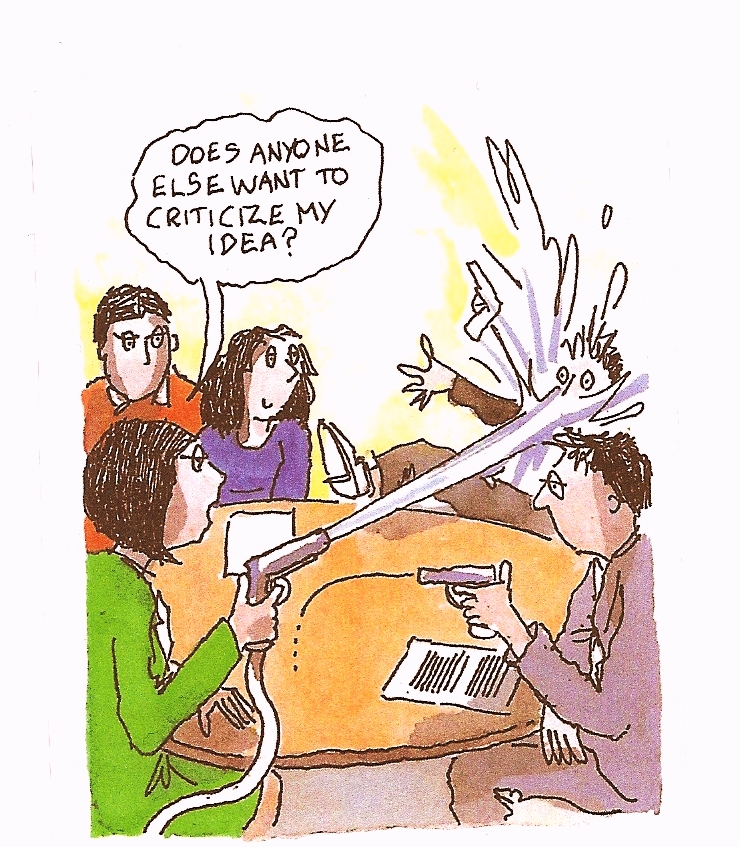
People at brainstorming meetings are armed with water pistols. Criticizing brainstorms is strictly forbidden and those who can’t resist their critical impulses get squired; other companies use Nerf balls for offenders.
An agenda is sent out for meetings, with item number one: ‘Three ideas from each person about improving work, saving money, or making money.’
Group members all have computers at meetings and ideas are projected onto a screen; people see themselves being heard. Other companies use anonymity to solicit thoughts, and find that public comments and anonymous comments can differ greatly, for example, forecasts of when a product might be delivered.
![]()
Now listen to three extracts from business people discussing what would happen if the ideas above were introduced into their companies. Match the extracts with the ideas.
Time, place and preparation will affect the success of a meeting. Choose the best and worst scenarios from the options below.
Time to have a meeting
|
Number of participants
|
Place to have a meeting
|
Order for agenda
|
|
Day to have a meeting
|
Place to sit at a rectangular meeting table
|
Table
|
Agenda
|
What would you do in the following situations? What should you do? Do the quiz alone first, then discuss your answers with other members of the group. Be honest!
Test your etiquette
You arrive late at a meeting.
a. Sit down quietly without saying anything.
b. Apologize to the chairperson.
You have a bad cough and cold. You keep on coughing and sneezing.
a. Apologize.
b. Say nothing.
You can’t understand what someone is saying because he’s speaking with his hand in front of his mouth.
a. Ask him to move his hand.
b. Hope that sooner or later he’ll move his hand.
One of your guests looks a little ill.
a. Ignore him/her.
b. Ask if he/she is OK.
You’re non-smoker. Someone sitting next to you lights up.
a. Ask him/her politely not to smoke.
b. Move your chair away a little.
You’re having a coffee break. You spill coffee on your colleague’s jacket.
a. Offer to pay for the jacket to be cleaned.
b. Apologize profusely and leave it at that.
You’re having a coffee break. Your mobile phone rings.
a. Answer it.
b. Let the answering machine take a message.
You’re a guest. You’re having coffee in a bar. It’s time to pay the bill.
a. Offer to pay.
b. Let your guest pay.
![]()
Pre reading Here is the outline to the article below. Can you guess what each point on the outline is about? Read the article and check your answers.
|
|
Business Meetings
Every business, whether it has 2 employees or 2,000, has meetings as a regular part of getting things done. Although employees can communicate with one another in an organization in many different ways, business meetings — if they are conducted in the right way — can be incredibly effective and efficient.
Meetings are not only one of the most important ways for employees to communicate within organizations, but they're also the way that teams get their work done. Although individual team members work on tasks outside of meetings, team meetings give members the opportunity to come together to determine the team's goals, its plans for achieving its goals, and who will do what — and when.
Take a close look at what makes meetings tick and find out how to conduct better business meetings.
The good news (and the bad) about meetings
What makes some meetings terrific, while others are simply the pits?
Employees benefit in several ways when a meeting is well run. Here's the good news about business meetings that fall into this category:
Meetings are empowering.
Meetings are a great way to communicate.
Meetings develop work skills and leadership.
Meetings are morale boosting.
Unfortunately, meetings are prone to fall into nonproductive pitfalls. Here's the negative side of meetings:
Meetings may not have focus.
Companies have too many meetings.
Attendees may be unprepared.
Most meeting time is wasted.
Eight ways to make meetings better
You can make your meetings better, and you don't have to tolerate meetings that accomplish little or nothing. The power is within you, whether you are a meeting leader or a participant. Do you want to find out how? Here are some time-tested techniques to ensure better business meetings:
Be prepared. Meetings are work, so, just as in any other work activity, the better prepared you are for them, the better the results you can expect.
Have an agenda. An agenda — a list of the topics to be covered during the course of a meeting — can play a critical role in the success of any meeting. It shows participants where they are going, but it's then up to the participants to figure out how to get there. Be sure to distribute the agenda and any pre work in advance. By distributing the agenda and pre work before the meeting, participants can prepare for the meeting ahead of time. As a result, they will be immediately engaged in the business of the meeting, and they'll waste far less time throughout the meeting.
Start on time and end on time. Everyone has suffered through meetings that went way beyond the scheduled ending time. That situation would be fine if no one had anything else to do at work. But in these days of faster and more flexible organizations, everyone always has plenty of work on the to-do list. If you announce the length of the meeting and then stick to it, fewer participants will keep looking at their watches, and more participants will take an active role in your meetings.
Have fewer (but better) meetings. Call a meeting only when it is absolutely necessary. Before you call a meeting, ask yourself whether you can achieve your goal in some other ways, perhaps through a one-on-one discussion with someone in your organization, a telephone conference call, or a simple exchange of e-mail. As you reduce the number of meetings you have, be sure to improve their quality.
Include, rather than exclude. Meetings are only as good as the ideas that the participants bring forward. Great ideas can come from anyone in an organization, not just its managers.
Maintain the focus. Meetings can easily get off track and stay off track. The result? Meetings do not achieve their goals. Meeting leaders and participants must actively work to keep meetings focused on the agenda items. Whenever you see the meeting drifting off track, speak up and push the other attendees to get it back in focus.
Capture and assign action items. Unless they are held purely to communicate information, or for other special purposes, most meetings result in action items, tasks, and other assignments for one or more participants. Don't assume that all participants are going to take their assignments to heart and remember all the details. Instead, be sure that someone has agreed to take on the job of record keeping. Immediately after the meeting, summarize the outcome of the meeting, as well as assignments and timelines, and e-mail a copy of this summary to all attendees.
Get feedback. Every meeting has room for improvement. Be sure to solicit feedback from meeting attendees on how the meeting went right for them — and how it went wrong. Was the meeting too long? Did one person dominate the discussion? Were attendees unprepared? Were the items on the agenda unclear? Whatever the problems, you can't fix them if you don't know about them. You can use a simple form to solicit feedback, or you can simply informally speak with attendees after the meeting to get their input.
Steps in conducting a meeting
The following are some tips to help you make your next meeting successful, effective and maybe even fun.
Before The Meeting
Define the purpose of the meeting.
Develop an agenda in cooperation with key participants. See a sample agenda.
Distribute the agenda and circulate background material, lengthy documents or articles prior to the meeting so members will be prepared and feel involved and up-to-date.
Choose an appropriate meeting time. Set a time limit and stick to it, if possible.
If possible, arrange the room so that members face each other, i.e. a circle or semi-circle. For large groups, try U-shaped rows.
Choose a location suitable to your group's size. Small rooms with too many people get stuffy and create tension. A larger room is more comfortable and encourages individual expression.
Use visual aids for interest (e.g. posters, diagrams, etc.). Post a large agenda up front to which members can refer.
Vary meeting places if possible to accommodate different members. Be sure everyone knows where and when the next meeting will be held.
During The Meeting
Greet members and make them feel welcome, even late members when appropriate.
If possible, serve light refreshments; they are good icebreakers and make your members feel special and comfortable.
Start on time. End on time.
Review the agenda and set priorities for the meeting.
Stick to the agenda
Encourage group discussion to get all points of view and ideas. You will have better quality decisions as well as highly motivated members; they will feel that attending meetings is worth their while.
Encourage feedback. Ideas, activities and commitment to the organization improve when members see their impact on the decision making process.
Keep conversation focused on the topic. Feel free to ask for only constructive and non- repetitive comments. Tactfully end discussions when they are getting nowhere or becoming destructive or unproductive.
Keep minutes of the meeting for future reference in case a question or problem arises.
As a leader, be a role model by listening, showing interest, appreciation and confidence in members. Admit mistakes.
Summarize agreements reached and end the meeting on a unifying or positive note.
Set a date, time and place for the next meeting.
After The Meeting
Write up and distribute minutes within 3 or 4 days. Quick action reinforces importance of meeting and reduces errors of memory.
Discuss any problems during the meeting with other officers; come up with ways improvements can be made.
Follow-up on delegation decisions. See that all members understand and carry-out their responsibilities.
Give recognition and appreciation to excellent and timely progress.
Put unfinished business on the agenda for the next meeting.
Conduct a periodic evaluation of the meetings. Note any areas that can be analyzed and improved for more productive meetings. See a sample meeting evaluation.
And remember, effective meetings will keep them coming back.
Reading comprehension
Exercise 1
Complete the sentences from the text.
Meetings are not only one of the most important ways for employees to communicate within organizations, but ...
You can make your meetings better, and ...
Meetings are work, so, just as in ...
By distributing the agenda and pre work before the meeting, participants can...
Meetings are only as good as...
Meeting leaders and participants must actively work to ...
Tactfully end discussions when…
Discuss any problems during the meeting with other officers; come up…
Exercise 2
When you attend a meeting, what should you do to achieve your own objectives and help make them more effective? Tick the points you agree with.
Before the meeting
Read the minutes of the previous meeting (and other relevant documents).
Make up your mind about key issues and be prepared to convince everyone that you are right.
During the meeting
Make only relevant and interesting points.
Make sure everyone understands your point of view.
Speak loudly and repeat your ideas often.
Listen carefully to other people’s points of view.
Don’t say anything because you might sound stupid.
Don’t discuss too much because you want to finish the meeting quickly.
Avoid any conflicts or disagreements
Find out what different people think.
Try to reach a conclusion that everyone can feel satisfied with.
Exercise 3
Put the steps in the logical order. The first and the last steps are correct.
|
|
|
|
|
|
|
|
|
|
|
|
|
|
|
|
|
|
|
|
|
|
![]()
Listen to a group of new employees at a training session discussing how meetings should be organized. As you listen, complete the note on the elements of meetings.
THE ESSENTIALELEMENTS OF MEETINGS |
1. A purpose: ……………………………….. ……………………………….. ………………………………..
|
2. An ……………………..showing the list of items to be covered
|
3. ………………………… - the……………………. (or ………………………..) to control the meeting
- the…………………….to keep a record of the proceedings - the other participants
|
4. ……………………………..
|
5. A…………………………..: normally the…………………..of the meeting
|
Exercise 1
Match the terms with their definitions.
|
|
Exercise 2
Business Meeting Verbs
There are a lot of verbs which go very well with the word ‘meeting’. First guess their meaning, then fill in the gaps with the correct form of a suitable verb.
to adjourn to attend to brainstorm to cancel to commence to hold to over-run to postpone to reschedule to wrap up |
I'll be ……………a meeting today between 2 and 3pm.
Take a few minutes to ……………some ideas on a new name for this product.
The boss has decided to ……………the meeting as he is no longer interested in the project.
The meeting ……………at 9:30. Please don’t be late.
I'm ……………a meeting on the effects of the increase in shipping costs.
Sorry I'm late. My meeting ……………by 15 minutes.
Let’s ……………the meeting until the report has been finished.
Did you hear? There's no meeting today. It's been …………...for tomorrow at 12.
If there are no further comments, we will ……………the meeting here.
Let's ……………this meeting. We're out of time.
Exercise 3
Complete the following sentences with appropriate words from the list
agenda |
casting vote |
consensus |
minutes |
circulate |
apologies |
chairperson |
items |
arising |
conduct |
In all formal meetings and most informal meetings, there is a ……………whose job is to……………the business of the meeting and to ensure that the meeting’s objectives are achieved.
It is helpful in both formal and informal meetings to have an …………., listing the points that are to be discussed. It is usual to ……………this in advance so that participants can prepare adequately for the meeting.
If there are too many…………..on the agenda, it is inevitable that the meeting will be over-long and so less effective.
After formal meetings, the secretary writes up the ……………, an official record of the discussion that has taken place.
If you cannot attend a meeting, it is customary to send your ……………to the chairperson, who reads out the names of any absentees at the beginning of the meeting. After naming absentees, the chairperson may ask if there are any matters ……………out of the minutes of the last meeting.
When decisions must be taken, the chairperson hopes there will be a ……………on what should be done. Otherwise, a vote must be taken and sometimes the votes for and against are equal. If this happens, the only way to break the deadlock is for the chairperson to give his or her…………… .
Translate into English.


